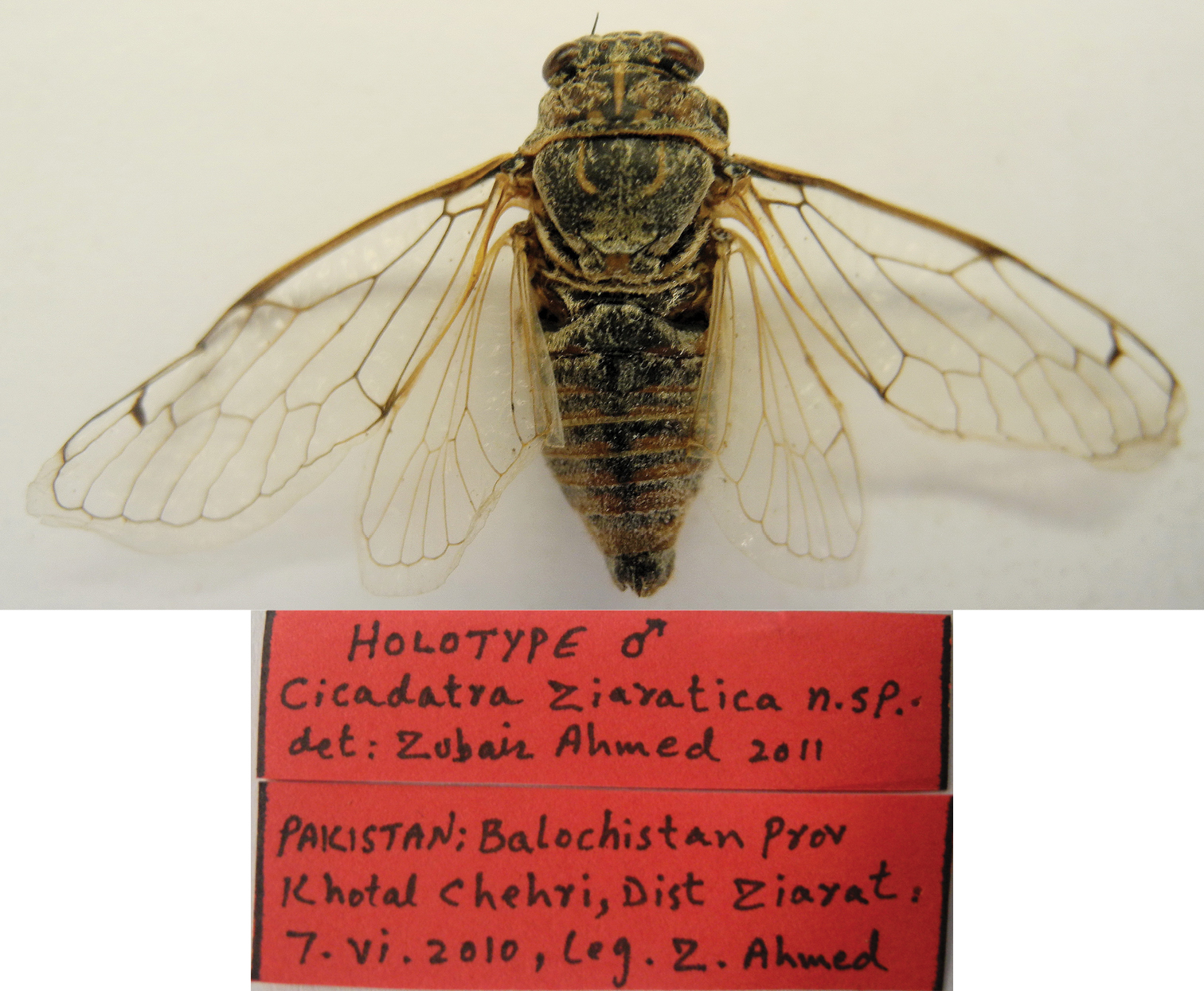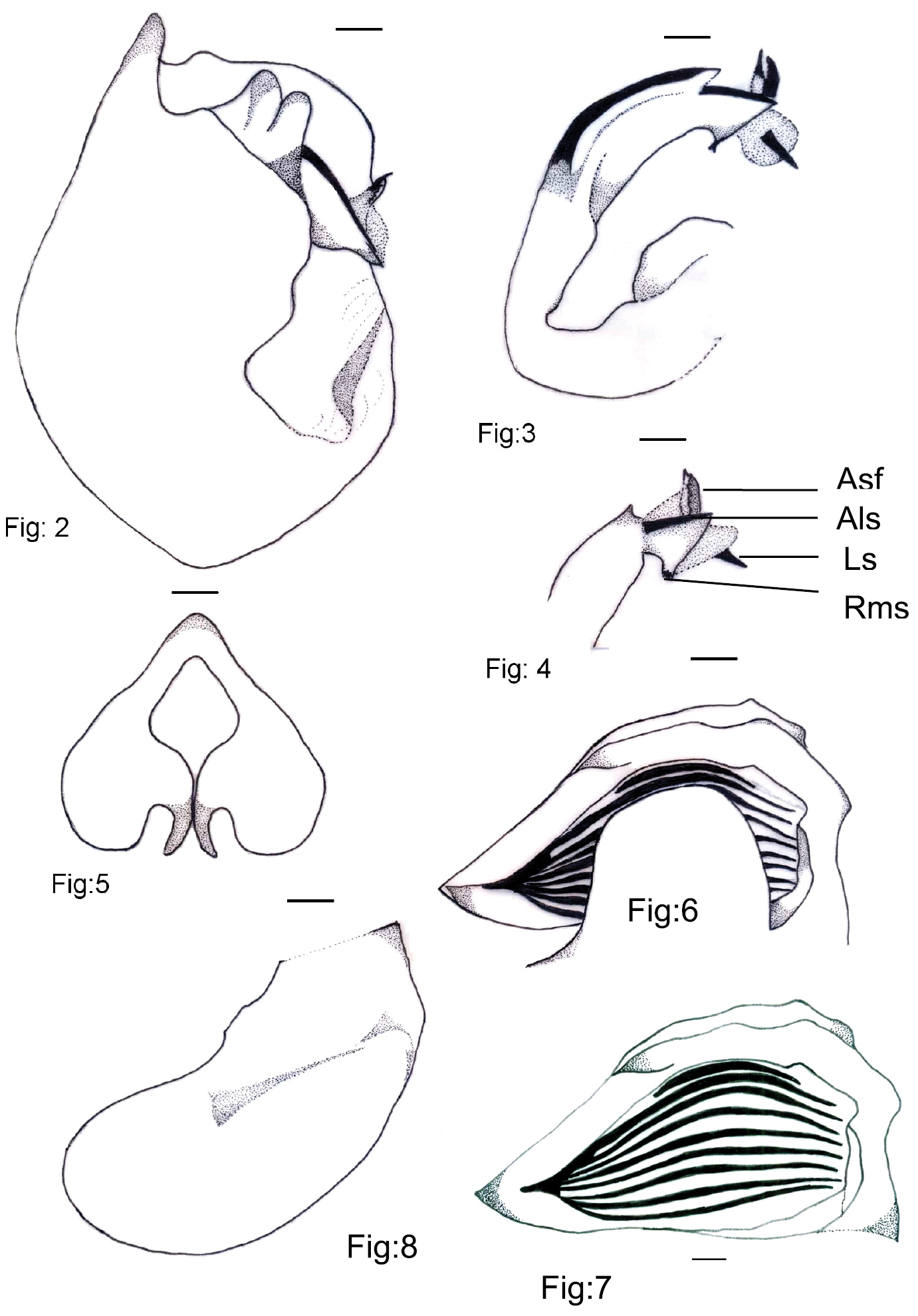






(C) 2012 Zubair Ahmed. This is an open access article distributed under the terms of the Creative Commons Attribution License 3.0 (CC-BY), which permits unrestricted use, distribution, and reproduction in any medium, provided the original author and source are credited.
For reference, use of the paginated PDF or printed version of this article is recommended.
A new species of cicada, Cicadatra ziaratica sp. n., is described from Pakistan. Male genitalia, timbal and opercula are described and illustrated as important diagnostic characters. Biological notes are also provided. A key to the known Cicadatra of Pakistan is provided.
Cicadatra species , taxonomy, Cicadidae, morphology
Species of the genus Cicadatra Kolenati, 1857 exhibit variability in several morphological characters. As a result, there is still much to learn about the distribution and composition of Cicadatra species across the range of the genus. Studies of Cicadatra species in the Middle East and Asia continue to illustrate the lack of knowledge about the species of this widespread genus. However, there have been some more recent studies which provide detailed analyses of the morphological characters of generally new species from this region (
The first checklist of the Pakistani cicada fauna was recently produced by
The present species is described from Pakistan as new to science, and is known only from the Ziarat District, Balochistan Province. Notes on the biology of this new species are also provided along with a key to differentiate the species from the known Pakistani Cicadatra.
Materials and methodsSpecimens were captured during June 2010 and June 2011 in Balochistan Province, Pakistan. Terminology follows
urn:lsid:zoobank.org:act:04C75272-8CDE-4677-A6EE-798512C83B53
http://species-id.net/wiki/Cicadatra_ziaratica
Figs 1–8Pakistan, Balochistan Province, Khotal Chehri, District Ziarat.
Holotype male, pinned. Original label: “Pakistan, Balochistan Province, Khotal Chehri, District Ziarat, 7.vi.2010, Collector, Zubair Ahmed”, “HOLOTYPE / Cicadatra ziaratica / Ahmed, Sanborn & Akhter” [handwritten label] (NHMK); one male paratype, “Pakistan, Balochistan Province, Khotal Chehri, District Ziarat, 7.vi.2010, Collector, Zubair Ahmed”, “PARATYPE / Cicadatra ziaratica / Ahmed, Sanborn & Akhter” [handwritten label]; three male paratypes, “Pakistan, Balochistan Province, Khotal Chehri, District Ziarat, N, 3.vi.2011, Collector, Zubair Ahmed “PARATYPE / Cicadatra ziaratica / Ahmed, Sanborn & Akhter” [handwritten label] (ZACP).
The new species appears to be most allied morphologically to Cicadatra lorestanica
Male. General color of body black with olive to ochraceous markings and white pile.
Head black with white pile particularly on posterior edge, head including eyes as broad as mesonotum; eyes brown, varying from light to dark in different specimens; ocelli orangish, piceous in some specimens; postclypeus black with a central sulcus and obvious transverse grooves, dense pile lateral of grooves, gena and lorum black with dense white pile; rostrum light ochraceous at base, darker towards apex, strongly passing intermediate coxae; labrum with sparse white pile laterally and on apex; antennae dark brown, apical segment faint yellow, vertex black, supra-antennal plate reaching eyes, black, light band at medially in two paratypes.
Pronotum black, brown in some paratypes, with median black biconcave mark containing a light olive green median fascia, an olive green patch crossing ambient fissure posterolateral to each side of median fascia, black mark continues around disc in ambient fissure and across lateral pronotal collar to the lateral angle; paramedian and lateral fissures variably marked with dark brown to black, pronotal collar black anteriorly and olive green across posterior half of lateral angles and posterior margin, ochraceous in some paratypes, white dense pile present on ambient, paramedian and lateral fissure and scattered pile on disc, pile reduced in some paratypes; mesonotum black or dark brown, with ochraceous J-shaped mark along parapsidal suture, mark triangularly shaped at base in some paratypes; cruciform elevation olive green (brown in some paratypes) medially, darkening to black in anterior arms; metanotum olive green (brown in some paratypes); thoracic sternites black with dense white pile, ochraceous in different specimens; some specimens with dark marking on basisternum 2, epimeron 2, katepisternum 2, and episternum 3.
Fore coxae light olive to ochraceous with black linear marking, middle coxae light ochraceous with broad dark anterolateral surface, hind coxae light ochraceous with darker laterally; fore and middle trochanter olive to ochraceous with a dark brown area at middle with white pile; fore femorae dark brown with white pile and light areas on ventral apex with strongly angled primary spine, erect secondary spine and a small angled apical spine; middle femora dark brown with a yellow area at ventral and apex with dense white pile, hind femora dark brown with yellow area on base and apex; fore tibiae dark brown lighter at apex, middle tibiae dark brown with white pile and yellow at lateral, hind tibiae yellow, half dark brown with five brown tibial spurs and sparse white pile; tibial spurs and combs brown, darker towards their apices; tarsi black; pretarsal claws dark brown.
Fore wings hyaline with faint yellow and brown venation, radial (r) and radiomedial (r-m) crossveins at bases of apical cells 2 and 3 darkly infuscated, infuscation on r-m absent or reduced in some paratypes, basal call twice as long as wide; fore wings with 8 apical cells, basal membrane light reddish; hind wings with faint yellow venation, light grey infuscation around anal veins 2 and 3 (2A and 3A), hind wings with 6 apical cells.
Male opercula light brown with black spot on lateral base and rather dense white pile, rounded, and slightly overlapped, not meeting medially in paratypes, meracanthus triangular, light ochraceous with black spot at base.
Abdominal tergites black with white pile more or less located near the anterior edge of each tergum, tergites 2–7 with a light area on posterior except median part, timbal cavity exposed; timbal cover incomplete covering about half the timbal, black or dark brown with white pile, timbal with 9 ribs; abdominal sternites brown with dense white pile, epipleurites dark brown with dense white pile.
Male pygofer dark brown with scattered pile, dorsal beak pointed, upper lobe of pygofer rounded, basal lobe of pygofer appears as a bud like projection beneath the upper lobe; uncus very short; claspers tapering to a point, curved slightly laterad, close to each other at base; aedeagus with theca curved, a lateral scleritized, serrate appendages, a long, subapical spine, a ventral scleritized, rounded serrate process, a lateral and a median long spine.
Female. Unknown.
Holotype Male, Cicadatra ziaratica sp. n.
Cicadatra ziaratica sp. n., 2 Male pygofer lateral view 3–4 Aedeagus 5 Claspers 6 Timbal cover 7 Timbal 8 Operculum. Scale lines = 0.6 mm. Asf Aedeagus with serrated flap Als Aedeagus long spine Ls Lateral spine Rss Row of middle spines
The species is named for the district of Balochistan from which the type series was collected.
(mm). N=5 males, mean (range). Length of body: 16.9 (16.0–18.0); length of fore wing: 20.2 (19.0–22.0); width of fore wing: 6.7 (6.1–7.0); width of head including eyes: 4.6 (4.0–5.0); width of pronotum including paratota: 5.7 (5.5–6.0); width of mesonotum: 5.1 (4.8–5.5).
All specimens were collected during 2010 and 2011 in the vicinity of Ziarat between 3 June–7 June. The cicadas emerged among wild grasses based on the location of the emergence holes. Adult males called from these same grasses as well as from shrubs including Peganum harmala L.
Key to the males of Cicadatra of Pakistan
| 1 | Body length >24 mm, prontoal collar almost or entirely black | 2 |
| – | Body length <24 mm, pronotal collar heavily marked with ochracous, olivaceous or tawny | 4 |
| 2 | Pronotal disk black | Cicadatra acberi (Distant, 1888) |
| – | Pronotal disk ochraceous | 3 |
| 3 | Supra-antennal plate, cruciform elevation, and costal margin tawny | Cicadatra persica Kirkaldy, 1909 |
| – | Supra-antennal plate and cruciform elevation black, costal margin castaneous | Cicadatra gingat China, 1926 |
| 4 | Head castaneous | Cicadatra raja (Distant, 1906) |
| – | Head black | 5 |
| 5 | Radial and radiomedial crossveins not infuscated | 6 |
| – | Radial and/or radiomedial crossveins infuscated | 7 |
| 6 | Pronotum castaneous marked with black, cruciform elevation black, male opercula overlapping medially, small marginal spot on hind wing | Cicadatra sankara (Distant, 1904) |
| – | Pronotum dark ochraceous marked with black, cruciform elevation marked with ochraceous, male opercula almost meeting medially, hind wing hyaline | Cicadatra karachiensis Ahmed, Sanborn and Hill, 2010 |
| 7 | Postclypeus black | Cicadatra ziaratica sp. n. |
| – | Postclypeus tawny marked with castaneous or black | 8 |
| 8 | Postclypeus with transverse grooves black | Cicadatra walkeri Metcalf, 1963 |
| – | Postclypeus with medial castaneous or black stripe | Cicadatra xanthes (Walker, 1850) |
ZA thanks Tim McNary, Colorado USA for providing pertinent literature. Collection of specimens was partially supported by the U.S National Science Foundation under Grants No. DEB 07-20664 and DEB-09-55849. Any opinions, findings, and conclusions or recommendations expressed in this material are those of the authors and do not necessarily reflect the views of the NSF. Max Moulds and an anonymous reviewer made suggestions to improve the manuscript.

